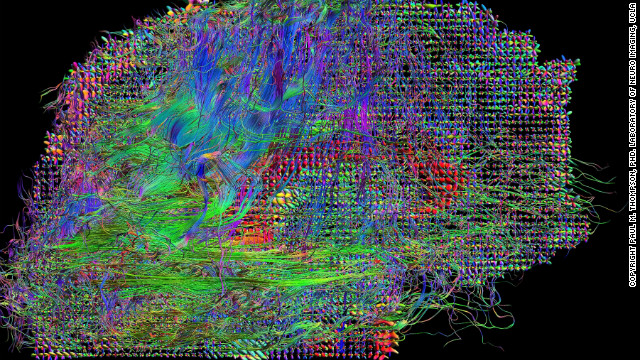Category: News
"Stroking" Neurons
We have many different types of neurons within our peripheral somatosensory system. In addition to basic mechanoreceptors, we have neurons corresponding to pain sensations, and channels that are temperature sensitive. However, one phenomenon that was not explained at the neuronal level until recently, is the sensation of stroking. On the behavioral level, we know that stroking or grooming is pleasurable in such phenomenon as maternal care. But how is this transduced at the molecular level?
Researchers in David Anderson’s lab at Caltech recently discovered a class of neurons that selectively responds to “massage-like” stimulations. Experiments were performed in-vivo to directly measure the effect of certain stimulations. Calcium imaging, a type of imaging designed to study activity of neurons, was used in the spinal cord, where the cell bodies of neurons projecting to the periphery are located. After mice were pinched, poked, and light-touch stroked on their paws, the researchers found that a subset of neurons was selectively activated to only the light-touch stimulus.
Turn That Frown Upside Down. Really, though. It’s Good for You.

It may be an age-old saying that makes most people groan whenever a friend or family member feels the need to say it, but there are actual psychological benefits that come from simply putting on a smile. Researchers have been examining this phenomenon for a few decades now and even though it is not a new age, 21st century discovery, it is nonetheless amazing and unexpected. One would intuitively assume that facial expressions are an external representation of what is going on inside the brain. Classically, facial expressions are considered to be influenced by mood and thought. It seems to be a one-way street in which the brain controls the face, but this is not the case.
Charles Darwin hypothesized that emotional facial expressions are an innate and universal human characteristic. A happy face is a happy face no matter where you are in the world. This theory has been thoroughly explored and psychologists have produced evidence that supports this century-old speculation. This is convenient in a way, because if facial expressions were specific to a geographic region, people would have to learn faces as if they were learning a new language. What a challenge that would be! But the more interesting aspect to these universal facial expressions is that the physical expression can directly influence one’s emotions.
More
Connectome Progress Report
The Human Connectome Project (HCP) has started trials on volunteers with a state-of-the-art scanner.

New maps of the networks of live brains could lead to better treatments for neurological disorders
Today's technology allows neuroscientists to map the brain's connections on an unprecedented level of detail. The ultimate goal of the HCP is to create a map, or connectome, of every neuron and synapse to better understand how the brain works. A better understanding of the brain means a better understanding of brain disorders like schizophrenia or autism, which in turn means better treatment.
More
Mapping the Human Brain
By mapping the human brain, we will inevitably have a greater comprehensive understanding of how it functions. In this TED talk, Allan Jones explains how his team of researchers is mapping the brain by investigating which genes are turned on in each region and how these regions link up. According to Allan Jones: "Understanding how our genes are used in our brains will help scientists and the medical community better understand and discover new treatments for the full spectrum of brain diseases and disorders."
Out of Madness Comes Life: Are The Arts Crazy?
Sometimes, writing is tough. The passion isn't there, and every word is a struggle. We've all had those moments when forced to do something artistic or creative, whether it be writing or drawing or playing an instrument (or anything really). We're just not into it, we don’t feel the pulse of the art pounding in our blood. Yet at other times, it’s like our blood rushes in a massive torrential pour, as if it had been held back by a massive dam for a thousand years. Whether its a subject that makes you jump for joy, a song you can head-bang to, or some other Picasso, some things just burst forth in a sudden and fervent explosion of productivity and creativity.

A Tongue Twister: Are Artists' Artistry Artful?
I think we've all had those moments when the pieces all click together, and a piece of work flows from us as easily as a hot knife through butter. During those moments, we feel alive, throbbing with a vibrant energy as our whole being is focused onto a single task. It’s an exhilarating feeling, yet at the same time, when you finally come down out of this strange natural high, it feels as though there was something slightly wrong about that, as if those who are capable of reaching that level often must have something wrong with them.
More
The Present State of Brain-Machine Interfaces
We live in an era where the rapid advances in technology are constantly changing how we perceive and interact with the world around us. The question on everyone's mind is always "what's next?" The answer: brain-machine interfaces. For the average consumer, brain-computer interfaces are becoming increasingly available on the mass market and their current uses offer a wide range of fascinating opportunities.
A company that's been in the news a lot lately is NeuroVigil. Their product known as the iBrain has been used to help world-renowned astrophysicist Steven Hawking communicate with a computer simply by thinking. Hawking, who suffers from Lou Gehrig's disease, developed his own solution to allow him to speak by twitching his cheek to select words from a computer. In its current state, the iBrain is still slower than Hawking's solution, but NeuroVigil's founder MD Philip Low hopes that it will eventually be possible to read thoughts aloud. NeuroVigil also made the news by signing a contract with Roche, a major Swiss pharmaceutical company, to use the iBrain in clinical studies for evaluating drugs for neurological diseases.
Maybe Being a Psychopath Isn’t Such a Bad Thing?
It’s Halloween, folks, and you know what that means: Jell-O molds of brains and punn-y costumes (Freudian Slip, anyone?), right? Amirite? Okay, maybe that’s just me, whatever, guys. But I can name at least one cherished Halloween pastime that tends to be pretty popular across the board, and that’s the horror movie marathon.
As we learned earlier this month, the mechanisms by which our brains process fear are intricate yet animalistic—after all, we’re by far not the only species that experiences the sensation of fear. Though what may be a uniquely human instinct is the propensity to actually seek out fear (and the sensation of arousal that inherently comes with it)—a concept illustrated nicely in this piece from The Dana Foundation. This purposeful seeking-out of fear-inducing stimuli is undoubtedly present in the act of partaking in the aforementioned horror movie marathon, and a particular subset of said scary flicks (and the characters therein) will serve as the main focus of this post.
There are lots of types of scary movies out there, from the psychological thriller to the slasher film and everything in between, but today, for the purposes of this entry, our interests lie in the psychopathic killers. Whether your allegiances fall with Freddy Kruger or Jason Voorhees, the psychopath is a popular character in cinema and in popular culture in general. But what makes this character profile so enjoyable and even attractive at times? And furthermore, what can we learn from the psychopaths among us?

- America's favorite psychopath.
Tanning: A "Real" Addiction?
Tanning is just one of those things, like chain smoking or base-jumping, that I’ve never cared to try; I am nowhere near athletic enough to attempt jumping off of a mountain face. I am also too, well, white to bask in the natural sun without SPF 50 sunscreen; like most people with skin of Fitzpatrick Scale type of I or II, I burn to a crisp and spend the next half-week smoothing aloe on my skin and crying in regret. More
High Definition Fiber Tracking
There are numerous brain imaging techniques that allow us to gain insight into what damage the brain may have incurred after a patient has a traumatic injury. The ever popular fMRI measures blood flow to infer neural activity. Diffusion tensor imaging (DTI) uses the magnetic properties of water to look at white matter in the brain, while positron emission tomography (PET) uses radiolabeling to look for a specific chemical in the brain. All of these are important for possible disease diagnosis, however, there is skepticism around how dependent we should be on this technology, as the results should never be taken as the absolute truth.

Comparison of X-Ray to HDFT
Now, a new type of brain imaging developed by researchers at the University of Pittsburgh allows researchers to look for connections that have been broken as a result of traumatic brain injury, much like an X-Ray allows doctors to look for broken bones. It is called High Definition Fiber Tracking (HDFT). Although the technology is not specific at the cellular level, it is accurate in observing specific connections that have been lost as a result of injury. These lost connections act as a reliable predictor for cellular information, such as the percentage of axons that have been lost.
The accompanying publication in the Journal of Neurosurgery focuses on a case study of a man who sustained severe brain damage after crashing an all-terrain vehicle (public service announcement: this is why we wear helments!!!). Initial MRI scans showed hemorrhaging in the right basal ganglia, which was confirmed by a later DTI. The patient had extreme difficulty moving the left side of his body, and it was assumed to be a result of damage to the basal ganglia. It was not until the patient had a HDFT test that doctors could pinpoint the true problem: fiber tracts innervating the motor cortex had been lost. More
Monitoring Brain Activity During Studying to Predict Test Performance
A research team led by Laura Matzen at Sandia National Laboratories in Albuqurque, NM has demonstrated that it is possible to predict how well people will remember information by monitoring their brain activity while studying. Matzen's team monitored test volunteers with electroencephalography (EEG) sensors to make accurate predictions. Why bother making a prediction if the result will show how well someone remembered the information anyways? Matzen brought up this example, "if you had someone learning new material and you were recording the EEG, you might be able to tell them, 'You're going to forget this, you should study this again,' or tell them, 'OK, you got it and go on to the next thing." Essentially providing a real-time performance metric, the applications of which many students would appreciate. More
